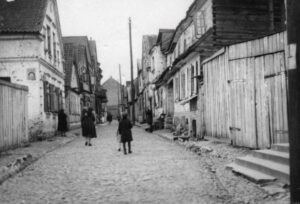In the second half of August 1943, Poleski Railway Station in Bialystok was again bursting at the seams with thousands of people, but this time it was not the Soviets who were taking away successive groups of deportees. Just over two years after the fourth mass deportation, these were Germans pushing people into the wagons. The victims were Jews from the Białystok ghetto, which had just been liquidated. The Germans took action on the night of 15 to 16 August 1943, surrounding the ghetto with three police cordons. They put up posters announcing the relocation of the Jews to Lublin. On the morning of 16 August, they began to move people out of their flats and gather them on Jurowiecka Street. That sparked the Jews – who had already set up an organisation that was drawing up plans for armed action against the Germans – to break away to fight. The activists of this Jewish underground knew very well that “displacement” simply meant death. The dramatically unequal strengths of the combatants led the Germans to declare the operation over as early as on 20 August. They murdered the fighting members of the resistance on the spot. The remaining Jews (according to estimates, there were about 30,000 people in the ghetto at that time) were led out of the ghetto while the fighting was still in progress. They were held in the open air in a field for several days before being transported to the camps at Auschwitz and Treblinka. The wagons carrying them to their deaths departed from the Poleski Station, just a few hundred metres from where the Sybir Memorial Museum is located today. The liquidation of the Białystok ghetto also marked the end of the existence of the city’s Jewish community. Before the outbreak of World War II, Jews accounted for more than 40% of the city’s population. Only a few hundred survived the war.
15.08.1943 – Deportations of Jews from the Białystok ghetto
Data publikacji: 20221027




